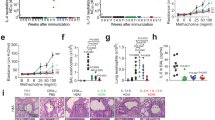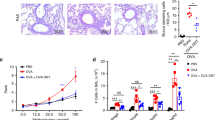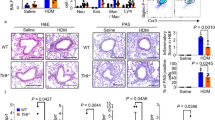Abstract
Interleukin 4 (IL-4) is essential for the switching of B cells to IgE antibody production and for the maturation of T helper (Th) cells toward the Th2 phenotype. These mechanisms are thought to play a crucial role in the pathogenesis of the allergic airway inflammation observed in asthma. In the present study, we examined the anti-inflammatory effects of DNA administration of murine IL-4 mutant Q116D/Y119D (IL-4 double mutant, IL-4DM), which binds to the IL-4 receptor α and is an antagonist for IL-4. Immunization of BALB/c mice with alum-adsorbed ovalbumin (OVA) followed by aspiration with aerosolized OVA resulted in the development of allergic airway inflammation. A single administration of IL-4DM DNA before the aerosolized OVA challenge protected the mice from the subsequent induction of allergic airway inflammation. Serum IgE level and extent of eosinophil infiltration in bronchoalveolar lavage (BAL) from IL-4DM DNA-administered mice were significantly lower than those in BAL from control plasmid-immunized mice. In our study, IL-4 or IL-4 mutants were not detected in sera from mice that had received a single administration of IL-4DM DNA. The results of this study provide evidence for the potential utility of IL-4 mutant antagonist DNA inoculation as an approach to gene therapy for asthma.
This is a preview of subscription content, access via your institution
Access options
Subscribe to this journal
Receive 12 print issues and online access
$259.00 per year
only $21.58 per issue
Buy this article
- Purchase on Springer Link
- Instant access to full article PDF
Prices may be subject to local taxes which are calculated during checkout






Similar content being viewed by others
References
Umetsu DT, DeKruyff RH . Th1 and Th2 CD4+ cells in human allergic disease. J Allergy Clin Immunol 1997; 100: 1–6.
Wills-Karp MJ et al. Interleukin-13: central mediator of allergic asthma. Science 1998; 282: 2258–2261.
Bentley AM et al. Increases in activated T lymphocytes, eosinophils, and cytokine mRNA expression for interleukin-5 and granulocyte/macrophage colony-stimulating factor in bronchial biopsies after allergen inhalation challenge in atopic asthma. Am J Respir Cell Mol Biol 1993; 8: 35–42.
Robinson DS et al. Predominant TH2-like bronchoalveolar T-lymphocyte population in atopic asthma. N Engl J Med 1997; 326: 298–304.
Cookson WO, Moffatt MF . Asthma: an epidemic in the absence of infection? Science 1997; 275: 41–42.
Shirakawa T, Emoto T, Shimizu S, Hopkin JM . The inverse association between tuberculin responses and atopic disorder. Science 1997; 275: 77–79.
Drazen JM, Arm JP, Austen KF . Sorting out the cytokines of asthma. J Exp Med 1996; 183: 1–5.
Brown MA, Hural J . Functions of IL-4 and control of its expression. Crit Rev Immunol 1997; 17: 1–32.
Noben-Trauth N, Hu-Li J, Paul WE . Conventional, naïve CD4+ T cells provide an initial source of IL-4 during Th2 differentiation. J Immunol 2000; 165: 3620–3625.
Plaut M et al. Mast cell lines produce lymphokines in responses to cross-linkage of FcɛRI or to calcium ionophore. Nature 1989; 339: 64–67.
Schroeder JT et al. IgE dependent IL-4 secretion by human basophils: the relationship between cytokine production and histamine release in mixed lymphocyte culture. J Immunol 1994; 153: 1808–1817.
Yoshimoto T, Paul WE . VD4pos, NK1.1pos T cells promptly produce interleukin 4 in response to in vivo challenge with anti-CD3. J Exp Med 1994; 179: 1285–1295.
Ferrick DA et al. Differential production of interferon-γ and interleukin-4 in response to Th1- and Th2-stimulating pathogenesis by γδT cells in vivo. Nature 1995; 373: 255–257.
Bjerke T et al. Human blood eosinophils produce and secrete interleukin 4. Respir Med 1996; 90: 271–277.
Cockcroft DW, Murdock KY . Comparative effects of inhaled salbutamol, sodium cromoglycate, and beclomethasone dipropionate on allergen-induced early asthmatic responses, late asthmatic responses, and increased bronchial responsiveness to histamine. J Allergy Clin Immunol 1987; 79: 734–740.
Coyle AJ et al. Mice lacking the IFN-γ receptor have impaired ability to resolve a lung eosinophilic inflammatory response associated with a prolonged capacity of T cells exhibit a Th2 cytokine profile. J Immunol 1996; 156: 2680–2685.
Gavett SH et al. Interleukin 12 inhibits antigen-induced airway hyper responsiveness, inflammation, and Th2 cytokine expression in mice. J Exp Med 1995; 182: 1527–1536.
Lack G et al. Nebulized IFN-γ inhibits the development of secondary allergic responses in mice. J Immunol 1996; 157: 1432–1439.
Coyle AJ et al. Interleukin-4 is required for the induction of lung Th2 mucosal immunity. Am J Respir Cell Mol Biol 1995; 13: 54–59.
Corry DB et al. Interleukin 4, but not interleukin 5 or eosinophils, is required in a murine model of acute airway hyperreactivity. J Exp Med 1996; 183: 109–117.
Hogan SP et al. Aeroallergen-induced eosinophilic inflammation, lung damage, and airways hyperreactivity in mice can occur independently of IL-4 and allergen-specific immunoglobulins. J Clin Invest 1997; 99: 1329–1339.
Grunewald SM et al. An antagonistic IL-4 mutant prevents type I allergy in the mouse: inhibition of the IL-4/IL-13 receptor system completely abrogates humoral immune response to allergen and development of allergic symptoms in vivo. J Immunol 1998; 160: 4004–4009.
Henderson Jr WR, Chi EY, Maliszewski CR . Soluble IL-4 receptor inhibits airway inflammation following allergen challenge in a mouse model of asthma. J Immunol 2000; 164: 1086–1095.
Tomkinson A . A murine IL-4 receptor antagonist that inhibits IL-4- and IL-13-induced responses prevents antigen-induced airway eosinophilia and airway hyperresponsiveness. J Immunol 2001; 166: 5792–5800.
Grunewald SM et al. A murine interleukin-4 antagonistic mutant protein completely inhibits interleukin-4 induced cell proliferation, differentiation, and signal transduction. J Biol Chem 1997; 272: 1480–1483.
Nelms K et al. The Il-4 receptor: signaling mechanisms and biologic functions. Annu Rev Immunol 1999; 17: 701–738.
Reiner P, Sebald W, Duschl A . The interleukin-4-receptor: from recognition mechanism to pharmacological target structure. Angew Chem Int Ed 2000; 39: 2834–2846.
Azzawi M et al. Identification of activated T lymphocytes and eosinophills in bronchial biopsies in stable atopic asthma. Am Rev Respir Dis 1990; 142: 1407–1413.
Kay AB . Asthma and inflammation. J Allergy Clin Immunol 1991; 87: 893–910.
Djukanovic R et al. Quantitation of mast cells and eosinophils in the bronchial mucosa of symptomatic atopic asthmatics and healthy control subjects using immunohistochemistry. Am Rev Respir Dis 1990; 142: 863–871.
Pesci A et al. Histochemical characteristics and degranulation of mast cells in epithelium and lamina propria of bronchial biopsies from asthmatic and normal subjects. Am Rev Respir Dis 1993; 147: 684–689.
Hasko G, Szabo C . IL-12 as a therapeutic target for pharmacological modulation in immune-mediated and inflammatory diseases: regulation of T helper 1/T helper 2 responses. Br J Pharmacol 1999; 127: 1295–1304.
Gately MK et al. The interleukin-12/interleukin-12-receptor system: role in normal and pathologic immune responses. Annu Rev Immunol 1998; 16: 495–521.
Lee Y, Fu C, Chiang B . Administration of interleukin-12 exerts a therapeutic instead of a long-term preventive effect on mite Der p I allergen-induced animal model of airway inflammation. Immunology 1999; 97: 232–240.
Lee YL, Fu CL, Ye YL, Chiang BL . Administration of interleukin-12 prevents mite Der p 1 allergen-IgE antibody production and airway eosinophil infiltration in an animal model of airway inflammation. Scand J Immunol 1999; 49: 229–236.
Car BD, Eng VM, Lipman JM, Anderson TD . The toxicology of interleukin-12: a review. Toxicol Pathol 1999; 27: 58–63.
Chung KF, Barnes PJ . Cytokines in asthma. Thorax 1999; 54: 825–857.
Huang TJ et al. Inhibitory effects of endogenous and exogenous interferon-gamma on bronchial hyperresponsiveness, allergic inflammation and T-helper 2 cytokines in Brown-Norway rats. Immunology 1999; 98: 280–288.
Boguniewicz M et al. Treatment of steroid dependent asthma with recombinant interferon-gamma. Clin Exp Allergy 1993; 23: 297–302.
Josef Erb K et al. Infection of mice with Mycobacterium bovis-Bacillus Calmette-Guerin (BCG) suppress allergen-induced airway eosinphilia. J Exp Med 1998; 187: 561–569.
Hansen G et al. Vaccination with heat-killed Listeria as adjuvant reverse established allergen-induced airway hyperreactivity and inflammation: role of CD8+ T cells and IL-18. J Immunol 2000; 164: 223–230.
Zhou CY et al. Anti-interleukin 4 inhibits immunogloburin E production in a murine model of atopic asthma. J Asthma 1997; 34: 195–201.
Tomaki M et al. Eosinophilopoiesis in a murine model of allergic airway eosinophilia: involvement of bone marrow IL-5 and IL-5 receptor alpha. J Immunol 2000; 165: 4040–4050.
Bost KL, Holton RH, Cain TK, Clements JD . In vivo treatment with anti-interleukin-13 antibodies significantly reduces the humoral immune response against an oral immunogen in mice. Immunology 1996; 87: 633–641.
Hayashi T et al. Interleukin-4-expressing plasmid inhibits reovirus type-2-triggered autoimmune insulitis in DBA/1J suckling mice. Int J Exp Pathol 2003; 84: 101–106.
Mistry AR et al. Recombinant HMG1 protein produced in Pichia pastoris: a nonviral gene delivery agent. Biotechniques 1997; 22: 718–729.
Zavorotinskaya T, Tomkinson A, Murphy JE . Treatment of experimental asthma by long-term gene therapy directed against IL-4 and IL-13. Mol Ther 2003; 7: 155–162.
Gurunathan S, Klinman DM, Seeder RA . DNA vaccines: immunology, application, and optimization. Annu Rev Immunol 2000; 18: 927–974.
Meng X et al. Keratinocyte gene therapy: cytokine gene expression in local keratinocytes and in circulation by introducing cytokine genes into skin. Exp Dermatol 2002; 11: 456–461.
Krinzman S et al. T cell activation in a murine model of asthma. Am J Physiol 1996; 271: L473–L481.
Acknowledgements
This work was supported by Health Science Research Grants from the Ministry of Health, Labor and Welfare of Japan and the Ministry of Education, Culture, Sports, Science and Technology of Japan.
Author information
Authors and Affiliations
Rights and permissions
About this article
Cite this article
Nishikubo, K., Murata, Y., Tamaki, S. et al. A single administration of interleukin-4 antagonistic mutant DNA inhibits allergic airway inflammation in a mouse model of asthma. Gene Ther 10, 2119–2125 (2003). https://doi.org/10.1038/sj.gt.3302131
Received:
Accepted:
Published:
Issue Date:
DOI: https://doi.org/10.1038/sj.gt.3302131
Keywords
This article is cited by
-
The Effect of Platanus orientalis L. Distillate on Mouse Model of Allergic Rhinitis
Iranian Journal of Science and Technology, Transactions A: Science (2020)
-
Mutant interleukin-4/13 signaling blockade successfully suppresses acute phase inflammation
Archives of Dermatological Research (2013)
-
Increased (6 exon) interleukin-7 production after M. tuberculosis infection and soluble interleukin-7 receptor expression in lung tissue
Genes & Immunity (2011)
-
Arsenic trioxide, a potent inhibitor of NF-κB, abrogates allergen-induced airway hyperresponsiveness and inflammation
Respiratory Research (2006)



